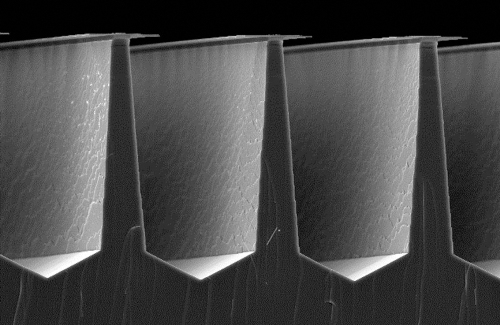Solar3D has successfully developed an initial prototype of its three-dimensional (3D) solar cell with the help of Panasonic equipment. The company used its economical fabrication process to accurately make 3D light capturing and converting nanostructures over a silicon wafer.

Image of the end view of the Solar3D prototype captured with a scanning electron microscope (Photo: Business Wire)
Solar3D’s breakthrough single wafer silicon solar cell leverages a 3D design featuring two robust and innovative patent-pending aspects, wide-angle light collection and high conversion efficiency. The simulated design efficiency is more than 25% or roughly 50% more when compared to silicon solar cells available in the marketplace. The unique wide-angle light collection feature on the surface of the solar cell is capable of trapping more light during morning and evening hours, and also in the winter months.
Solar3D’s Director of Technology, Dr. Changwan Son informed that the company has spent several months in perfecting the fabrication process. The company had then evaluated this process by creating a significant area of accurate 3D photovoltaic nanostructures on the silicon wafer surface. It achieved this success utilizing commercial equipment at the high-tech Nanofabrication Facility at the University of California, Santa Barbara (UCSB).
Solar3D’s Chief Executive Officer, Jim Nelson stated that the major challenge was to make a design that is producible and affordable. The extensive research work by Dr. Son and his group under the direction of Nadir Dagli, a Professor at UCSB, has helped the company in the development of a breakthrough, low-cost process to fabricate these nanostructures.
The company is submitting an additional patent application to safeguard its proprietary fabrication technique.
Disclaimer: The views expressed here are those of the author expressed in their private capacity and do not necessarily represent the views of AZoM.com Limited T/A AZoNetwork the owner and operator of this website. This disclaimer forms part of the Terms and conditions of use of this website.